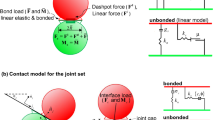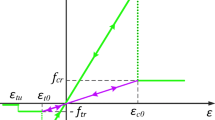Abstract
The macroscopic mechanical behavior of granular materials is closely related to the fabric anisotropy and contact force anisotropy. In order to investigate the microevolution of fabric and force anisotropy of rock masses containing non-coplanar intermittent joints under direct shear loading, this paper establishes a numerical model using the particle flow code (PFC) based on the distinct element method (DEM) and investigates the effects of non-coplanar intermittent joints on the evolutions in the fabric and force anisotropy and the distributions of contact forces of rock specimens by setting up specimens with different ligament angles of joints. Meanwhile, the shear strength, deformation characteristics and failure mode, energy dissipation were analyzed to deepen the understanding of the macroscopic mechanical behavior of the specimens from the microscopic mechanism. Three anisotropic tensors \({a}_{ij}^{c}\), \({a}_{ij}^{n}\) and \({a}_{ij}^{t}\) are defined to characterize the anisotropic behavior of the granular materials which can show the evolution law of fabric and mechanical anisotropy of the system under direct shear load. The findings indicate that the degree of fabric anisotropy increases with increasing ligament, and the length of the load side significantly influences the initial mechanical anisotropy of the specimen. Concurrently, a rise in the ligament angle impedes the progression of anisotropy within the specimen, leading to a substantial reduction in the macroscopic mechanical strength of the rock.
















Similar content being viewed by others
References
D Huang D Cen G Ma R Huang 2015 Step-path failure of rock slopes with intermittent joints Landslides 12 911 926 https://doi.org/10.1007/s10346-014-0517-6
M-A Brideau M Yan D Stead 2009 The role of tectonic damage and brittle rock fracture in the development of large rock slope failures Geomorphology 103 30 49 https://doi.org/10.1016/j.geomorph.2008.04.010
S Li X-T Feng Z Li B Chen C Zhang H Zhou 2012 In situ monitoring of rockburst nucleation and evolution in the deeply buried tunnels of Jinping II hydropower station Eng. Geol. 137–138 85 96 https://doi.org/10.1016/j.enggeo.2012.03.010
J Shang LJ West SR Hencher Z Zhao 2018 Geological discontinuity persistence: implications and quantification Eng. Geol. 241 41 54 https://doi.org/10.1016/j.enggeo.2018.05.010
M Oda 1982 Fabric tensor for discontinuous geological materials Soils Found. 22 96 108 https://doi.org/10.3208/sandf1972.22.4_96
Rothenburg, L., Bathurst, R.J.: Analytical study of induced anisotropy in idealized granular materials n.d.:14.
J Zhao N Guo 2015 The interplay between anisotropy and strain localisation in granular soils: a multiscale insight Géotechnique 65 642 656 https://doi.org/10.1680/geot.14.P.184
W Xu W Ren Y Liu C Liu S Cai 2022 Micromechanical behavior of jointed rock masses under uniaxial compression loading: a numerical study based on the discrete element method Europ. J. Environ. Civil Eng. 214 1 26 https://doi.org/10.1080/19648189.2022.2146205
PA Cundall ODL Strack 1979 A discrete numerical model for granular assemblies Géotechnique 29 47 65 https://doi.org/10.1680/geot.1979.29.1.47
M Rabiei P Samea A Shadi SA Ghoreishi-Madiseh 2023 A discrete element analysis for general failure behavior of basalt Int. J. Rock Mech. Min. Sci. 167 105394 https://doi.org/10.1016/j.ijrmms.2023.105394
U Castro-Filgueira LR Alejano DM Ivars 2020 Particle flow code simulation of intact and fissured granitic rock samples J. Rock Mechan. Geotech. Eng. 12 960 974 https://doi.org/10.1016/j.jrmge.2020.01.005
L Kong PG Ranjith BQ Li 2021 Fluid-driven micro-cracking behaviour of crystalline rock using a coupled hydro-grain-based discrete element method Int. J. Rock Mech. Min. Sci. 144 104766 https://doi.org/10.1016/j.ijrmms.2021.104766
B Liu Y Zhou Y-T Gao C Xu 2020 Experimental and numerical study on crack development characteristics between two cavities in rock-like material under uniaxial compression Theoret. Appl. Fract. Mech. 109 102755 https://doi.org/10.1016/j.tafmec.2020.102755
DO Potyondy PA Cundall 2004 A bonded-particle model for rock Int. J. Rock Mech. Min. Sci. 41 1329 1364 https://doi.org/10.1016/j.ijrmms.2004.09.011
Itasca Consulting Group. PFC 5.0 Documentation 2014.
Ivars, D.M., Potyondy, D.O., Group IC the smooth-joint con-tact model. In: 8th World Congress on Computational Mechanics (WCCM8), pp 29–31 (2015)
V Sarfarazi A Ghazvinian W Schubert M Blumel HR Nejati 2014 Numerical simulation of the process of fracture of echelon rock joints Rock Mech. Rock Eng. 47 1355 1371 https://doi.org/10.1007/s00603-013-0450-3
Y Li X Du Y Ji 2022 Prediction of the transitional normal stress of rock joints under shear Int. J. Rock Mech. Min. Sci. 159 105203 https://doi.org/10.1016/j.ijrmms.2022.105203
A Ghazvinian V Sarfarazi W Schubert M Blumel 2012 A study of the failure mechanism of planar non-persistent open joints using PFC2D Rock Mech. Rock Eng. https://doi.org/10.1007/s00603-012-0233-2
M Satake 1983 Fundamental quantities in the graph approach to granular materials Stud. Appl. Mechan. 7 9 19 https://doi.org/10.1016/B978-0-444-42192-0.50008-6
K Ken-Ichi 1984 Distribution of directional data and fabric tensors Int. J. Eng. Sci. 22 149 164 https://doi.org/10.1016/0020-7225(84)90090-9
LE Silbert GS Grest JW Landry 2002 Statistics of the contact network in frictional and frictionless granular packings Phys. Rev. E 66 061303 https://doi.org/10.1103/PhysRevE.66.061303
N Guo J Zhao 2013 The signature of shear-induced anisotropy in granular media Comput. Geotech. 47 1 15 https://doi.org/10.1016/j.compgeo.2012.07.002
H Ouadfel L Rothenburg 2001 `Stress–force–fabric’ relationship for assemblies of ellipsoids Mech. Mater. 33 201 221 https://doi.org/10.1016/S0167-6636(00)00057-0
S Zhao X Zhou 2017 Effects of particle asphericity on the macro- and micro-mechanical behaviors of granular assemblies Granular Matter 19 38 https://doi.org/10.1007/s10035-017-0725-6
S Zhao X Zhou W Liu 2015 Discrete element simulations of direct shear tests with particle angularity effect Granular Matter 17 793 806 https://doi.org/10.1007/s10035-015-0593-x
X Li H-S Yu 2013 On the stress–force–fabric relationship for granular materials Int. J. Solids Struct. 50 1285 1302 https://doi.org/10.1016/j.ijsolstr.2012.12.023
X Li HS Yu 2011 Tensorial characterisation of directional data in micromechanics Int. J. Solids Struct. 48 2167 2176 https://doi.org/10.1016/j.ijsolstr.2011.03.019
Li, X.: Micro-scale investigation on the quasi-static behavior of granular material. The Hong Kong University of Science and Technology, (2006)
Guo, N.: Multiscale characterization of the shear behavior of granular media. PhD the Hong Kong University of science and technology. (2014) doi https://doi.org/10.14711/thesis-b1334193
RJ Bathurst L Rothenburg 1990 Observations on stress-force-fabric relationships in idealized granular materials Mech. Mater. 9 65 80 https://doi.org/10.1016/0167-6636(90)90030-J
T Zhao GB Crosta G Dattola S Utili 2018 Dynamic fragmentation of jointed rock blocks during rockslide-avalanches: insights from discrete element analyses J. Geophys. Res. Solid Earth 123 3250 3269 https://doi.org/10.1002/2017JB015210
Y Zhao SJ Semnani Q Yin RI Borja 2018 On the strength of transversely isotropic rocks: on the strength of transversely isotropic rocks Int. J. Numer. Anal. Methods Geomech. 42 1917 1934 https://doi.org/10.1002/nag.2809
Q Sun J Zheng 2019 Two-dimensional and three-dimensional inherent fabric in cross-anisotropic granular soils Comput. Geotech. 116 103197 https://doi.org/10.1016/j.compgeo.2019.103197
Acknowledgements
The research presented in this paper was supported by the National Natural Science Foundation of China (Grant No.11972043) and the Natural Science Foundation of Hubei Province (Three Gorges Innovation Development Joint Fund) (Grant No. 2022CFD031)
Author information
Authors and Affiliations
Contributions
Kaiyuan Zhu (First Author): Conceptualization, Methodology, Software, Investigation, Formal Analysis, Writing - Original Draft; Guanhua Sun: Resources, Validation, Visualization, Writing - Review & Editing; Lu Shi (Corresponding Author): Visualization, Investigation, Methodology.
Corresponding author
Ethics declarations
Conflict of interest
The author declares that there is no conflict of interest.
Additional information
Publisher's Note
Springer Nature remains neutral with regard to jurisdictional claims in published maps and institutional affiliations.
Rights and permissions
Springer Nature or its licensor (e.g. a society or other partner) holds exclusive rights to this article under a publishing agreement with the author(s) or other rightsholder(s); author self-archiving of the accepted manuscript version of this article is solely governed by the terms of such publishing agreement and applicable law.
About this article
Cite this article
Zhu, K., Sun, G. & Shi, L. Shear-induced anisotropy analysis of rock masses containing non-coplanar intermittent joints. Arch Appl Mech 94, 841–864 (2024). https://doi.org/10.1007/s00419-024-02550-4
Received:
Accepted:
Published:
Issue Date:
DOI: https://doi.org/10.1007/s00419-024-02550-4




